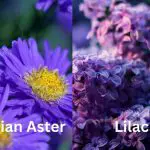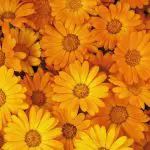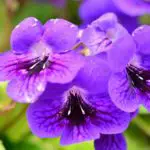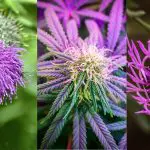Last Updated on May 11, 2023 by Derek
The most common yellow flowers in the farmer’s field are probably rapeseed flowers, also known as canola. Rapeseed is a commodity winter crop like rye and wheat. Farmers plant cover crops to improve the soil readiness for cash crops in the spring. They also reduce weed pressure and increase plant biomass.
What are the yellow flowers in farm fields?
Rapeseeds also help minimize soil erosion by wind and rain and retain soil microbial life. Other yellow flowers include:
- Sunflower
- Lilies
- Tulips
- Black-eyed Susan
- Yellow roses
- Daffodils
- Dahlia
- Strelitzia
- Thomas rose
- Compass flower
- Carnations
- Marigold
- Iris
- Begonia flowers
- Hibiscus
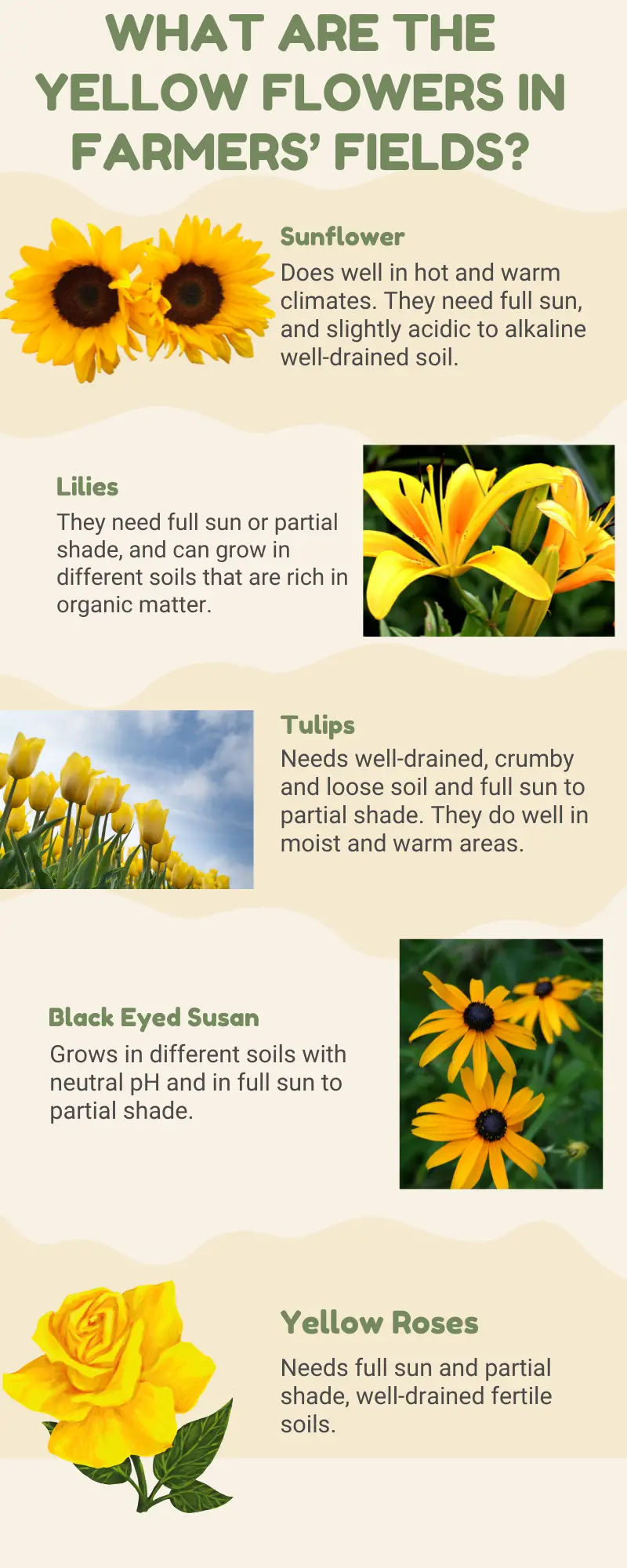
What Crop Has Little Yellow Flowers?
The tall crop with tiny bright yellow flowers is canola. It is one of the best cover crops as it produces the most growth and accumulates the most nitrogen in the above-ground biomass. Planting canola on your farm can have a considerable amount of humus. The canola seeds are good for making oil.
Canola plants are grown on more than 2 million acres in the United States, mostly in North Dakota, Kansas, Texas, and Oklahoma. In ND Yellow Fields are everywhere. The crop is also grown in Idaho, Oregon, and Washington. It is widely used in food and bioplastics.
Make sure you have the right conditions before planting canola. The plant can do well in a wide range of soil textures. It germinates well at temperatures between 37 and 41 degrees Celsius.
What Is Canola Plant Used For?
Canola has various uses, including baking and cooking at home, hotels, and food processing companies. Here are some of the diversified benefits of canola.
Vegetable oil
Canola is among the leading oilseed crops globally as it produces a large percentage of vegetable oil. The oil is fit for cooking and other purposes like baking and making any vegetable oil items as ingredients.
It is famous for its high omega3 level and as a source of vitamins K and E. many people, including cinemas, acknowledge the health benefit of canola oil and make the switch.
Livestock feed
The extraction of canola oil is by crushing canola seeds. After squeezing and extracting the oil, the leftover is rich food for livestock, pets, and fertilizers.
For good fats
Canola is rich in Alpha-linolenic acid (ALA) and Linoleic acid fatty acids, which the body needs but cannot produce. ALA is an omega3 fatty acid that reduces cholesterol levels in the body and prevents heart attacks and stroke. On the other hand, LA is rich in omega-6 and is essential for the brain and the growth and development of babies.
Other benefits of canola are that it has the lowest saturated fats, which are bad for the body.

Table – What state grows the most canola? Ranked from 1 to 10
[wptb id=5041]
Yellow flowered crops – Where Does Canola Grow Best?
The planting date significantly impacts how well the crop will do. Canola requires a minimum temperature of 32 degrees Celsius to germinate.
It can emerge at 41 degrees Celsius soil temperature but cannot exceed 50 degrees Celsius. The annual winter varieties do better in snowy places or regions with mild winter conditions.
It grows well on moderately textured, well-drained soils, with a low Ph of 5.5, and saline conditions. Canola’s tolerance to saline conditions makes it ideal for the newly drained dykes in Holland.
The crop needs about 16-18 inches of water to grow well during its season. It is the same plant family as cabbage and kale. It really is a wonderful site if you’re lucky enough to have a field behind your backyard.
Canola Flower
This belongs to a large family of plants; crucifers. It is to identify them due to their four bright yellow petals forming the shape of a cross. The canola flower produces a five-centimeter-long seed pod. The plant will change from green to light yellow color when ready for harvest.
Canola oil
Canola oil has a Canadian origin. It is vegetable oil with a low content of erucic acid. It comes from crushing the oil-rich seed. They produce edible and industrial oils.
What Is the Difference Between Canola and Rapeseed Oil?
It is often hard to tell the difference between canola and rapeseed oil as many countries use the two interchangeably (Canada, for example Other countries use rapeseed oil to mean oil for industrial use and canola to refer to edible cooking oil. There are notable differences between the two.
| Canola oil | Rapeseed oil |
| It contains a low amount of erucic acid, which is harmful to the body. It has 2% erucic acid and less than 30 micromoles of glucosinolate. | It has a higher level of harmful erucic acid than canola oil. |
| It is best for cooking at home and food processing plants. | It is good when adding to animal feeds. |
| Canola oil is a product of Canada (Can-Canada and ola-oil). It is a crossbreed of rapeseed to remove harmful components; erucic acids. | Rapeseed oil owes its origin in Poland before crossbreeding in Canada. |
| It is best for all culinary purposes. | It is suitable for industrial use in the chemical and automotive industries. |
| It is approved fit for human consumption. | The relationship between rapeseed oil’s high erucic acid level and cardiac hazard is still under research. It means rapeseed oil is yet to be confirmed good for human health. |
Canola Seed
Canola has tiny yellow flowers that contain small canola seeds. The seeds differ from poppy seeds due to their brownish-black color though the two are similar in size. One seed contains about 45 percent of canola oil.
Canola plant belongs to the same family as cauliflower, mustard, broccoli, and Brussels; the brassica plants.
Are Rapeseed Flowers Poisonous?
Yes, rapeseed flowers are poisonous, especially to dogs. While the yellow flower field appears attractive, it can pose a danger of allergic reactions, especially to sensitive pups.
One of the most common reactions is open wounds on the dog’s body. Researchers propose that rapeseed is one of the most dangerous plants to a dog due to the glucosinolates compound containing Sulphur.
Here are the reasons you need to keep your dog clear of rapeseed flower fields:
Deadly toxins
Eating any part of a rapeseed plant is highly toxic to a dog. It leads to hemolytic anemia, which can kill your dog. It can also cause difficulty breathing blindness and affect the nervous system.
Video Roundup – What’s growing in those fields of yellow flowers?
Other possibilities – Yellow Rocket

Yellow rocket cress (Barbarea vulgaris) is a biennial herb that belongs to the family Brassicaceae. It has many common names, including wintercress, herb barbara, rocketcress, and yellow rocket.
This herb is very versatile and is used in cooking, salads, and as a garnish.
Yellow rocket grows in moist, well-drained soil and is tolerant of light shade. Its vigorous growth occurs in early and mid-spring. This plant is native to Eurasia, but has become common in the United States. It can be found in a wide range of habitats, including cropland, fallow fields, vacant lots, construction sites, and meadows.
Yellow rocket flowers are attractive to bees and flies. They may also be attractive to Cabbage White butterflies (Pieris rapae), which can be spotted sucking on the flowers. Leaf beetles also feed on the foliage of yellow rocket. Although yellow rocket is not poisonous, large amounts of it can cause digestive upset.
| Common Name | Botanical Name | Soil pH Range | Soil Type | Sunshine | Growing Zones |
|---|---|---|---|---|---|
| Yellow Rocket Cress | Barbarea vulgaris | 6.0 – 7.5 | Well-draining | Full sun to partial shade | 3-9 |
Butterweed (aka Cressleaf Groundsel)

Butterweed is a common yellow flower that is found across the United States. It grows from Texas to Florida, from the Atlantic coast to Virginia and west to Nebraska.
This plant has become increasingly common in agronomic crop production areas. Butterweed is an annual that completes its life cycle in one year.
This weed forms rosette-like leaves that are held together by petioles. It blooms in late April and produces seeds in early May.
The yellow flower is about 12 to 25 mm wide, held on a stem that is blue-green. It attracts bees, which seek its nectar and pollen. Its blue-green leaves clasp the stem, and the lower basal leaves wither early.
| Common Name | Botanical Name | Soil pH Range | Soil Type | Sunshine | Growing Zones |
|---|---|---|---|---|---|
| Butterweed | Packera glabella | 6.0 – 7.0 | Well-draining | Partial to full shade | 4-8 |
Other yellow flowers
Daylilies
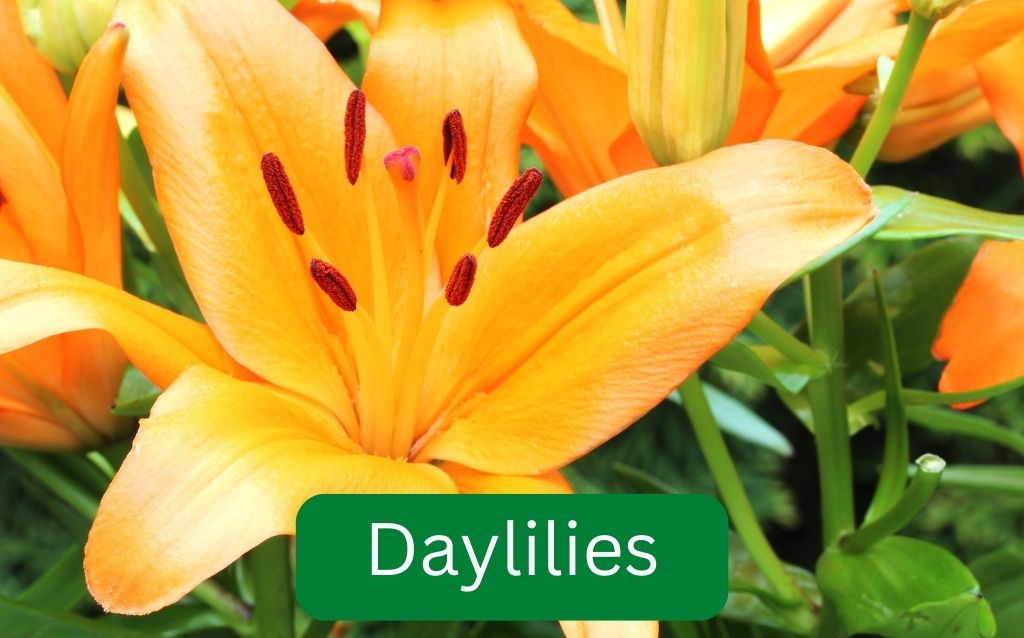
Daylilies have attractive funnel-shaped flowers that really stand out on a beautiful sunny day.
| Common Name | Botanical Name | Soil pH Range | Soil Type | Sunshine | Growing Zones |
|---|---|---|---|---|---|
| Daylilies | Hemerocallis spp. | 6.0 – 7.0 | Well-draining | Full sun to partial shade | 3-9 |
Bulbine

Originating from South Africa, Bulbine needs a hotter climate such as found in Florida or Texas, and is a member of the mustard or cabbage family.
| Common Name | Botanical Name | Soil pH Range | Soil Type | Sunshine | Growing Zones |
|---|---|---|---|---|---|
| Bulbine | Bulbine spp. | 6.0 – 7.5 | Well-draining, dry | Full sun | 8-11 |
Yellow Butterfly Bush

| Common Name | Botanical Name | Soil pH Range | Soil Type | Sunshine | Growing Zones |
|---|---|---|---|---|---|
| Yellow Butterfly Bush | Buddleja ‘Yellow Emperor’ | 6.0 – 7.0 | Well-draining, dry | Full sun | 5-9 |
Chrysanthemums
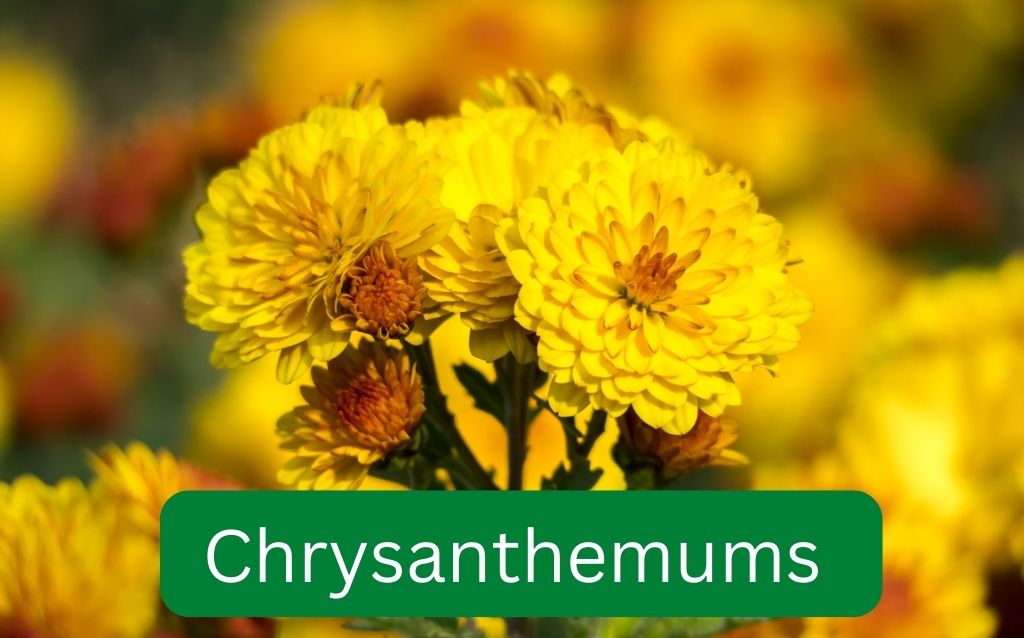
These plants can thrive in a variety of climates, growing bigger in warm climates, but can grow almost anywhere if giving care and attention in the growing season. Chrysanthemums don’t mind being in close proximity to other flower types – they are very gregarious!
| Common Name | Botanical Name | Soil pH Range | Soil Type | Sunshine | Growing Zones |
|---|---|---|---|---|---|
| Chrysanthemums | Chrysanthemum spp. | 6.0 – 7.0 | Well-draining, rich in organic matter | Full sun to partial shade | 3-9 |
Other flowers worth noting:
- Gerbera Daisies
- Prickly Pear
What are the fields of yellow flowers in Illinois?
Most of the plants found growing in Illinois fields are Butterweed, but it may well be Yellow Rocket as they are both common in the State.
What are the fields of yellow flowers in Kentucky?
Canola is widespread across farmer’s fields in Kentucky, so it’s probably that. It could also be Sunn Hemp.
What are the fields of yellow flowers in Tennessee?
It could be Canola, Dandelions or Buttercup.
Resources:
Butterweed is that Yellow Flower in Farm Fields – Hoosier Ag
What are those yellow flowers growing in farm fields?
What Is All That Yellow? | North Carolina Cooperative Extension
Those Yellow Flowers Dotting Fields Are Weeds, Farmers …


